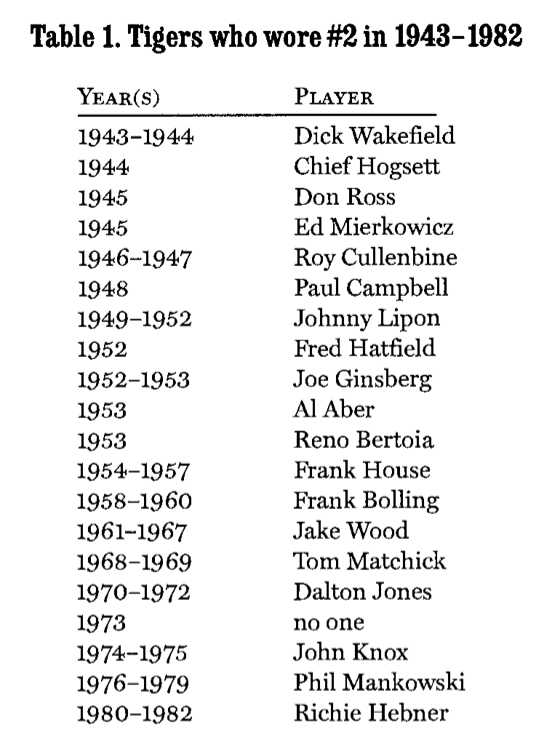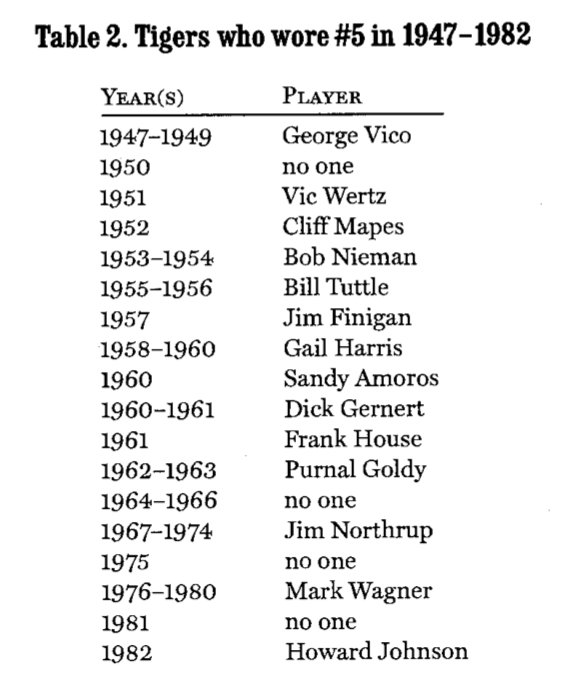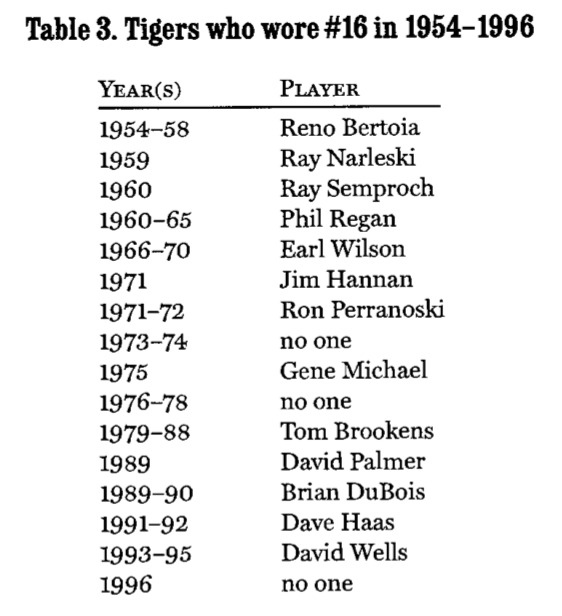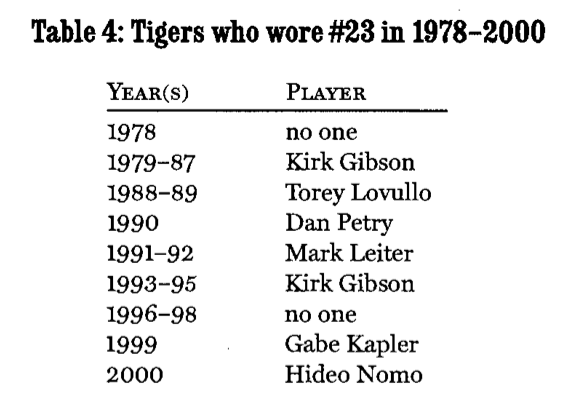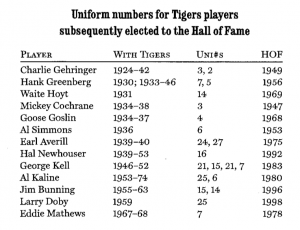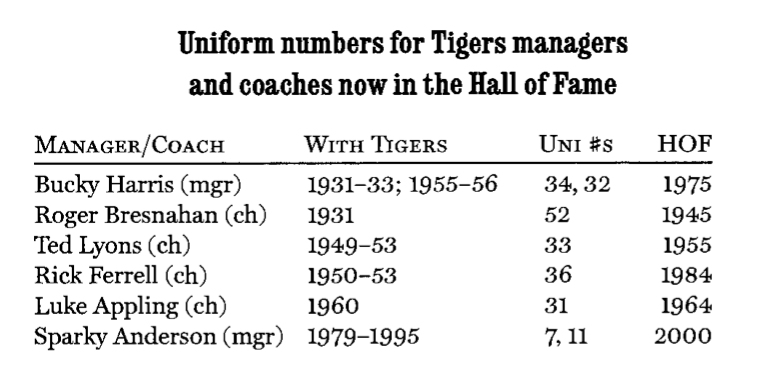Fascinating Aspects About the Retired Uniform Numbers of the Detroit Tigers
This article was written by Herm Krabbenhoft
This article was published in The National Pastime (Volume 26, 2006)
What makes these Detroit Tigers uniform numbers — 2, 5, 6, 16, and 23 — special?
Nearly every Tigers fan knows the answer to this question — each of those uniform numbers has been retired, in honor of Charlie Gehringer (2), Hank Greenberg (5), Al Kaline (6), Hal Newhouser (16), and Willie Horton (23).
Each of these five former Tigers greats was a top performer on the baseball diamond. Indeed, four of them have been enshrined at the Baseball Hall of Fame in Cooperstown, New York.
Appropriately, the official retirements of these five uniform numbers provided that no other Tiger players would ever wear them again. However, quite a few players have, in fact, worn those numbers — between the date the honored player last played for the Tigers and the actual date that the uniform number was officially retired. In addition, four of these honored Tigers also wore numbers other than their retired numbers.
Here are the fascinating histories of the retired uniform numbers of the Detroit Tigers.
Number 2
The first year that the Detroit Tigers used uniform numbers was 1931 with the season-opening game on April 14, at Sportman’s Park in St. Louis. Charlie Gehringer had been with Detroit since he made his major league debut on September 22, 1924. He became the regular second baseman in 1926. In 1931, he wore uniform number 3 (while Gee Walker, a rookie outfielder, wore #2).
That Gehringer wore number 3 was consistent with his slot in the batting order — at least at the beginning of the campaign. However, he missed much action during May, June, and July, and when he returned to the lineup, Charlie was stationed in the number 2 hole, which he kept for the remainder of the season. [It is noted that for virtually the entire 1931 campaign, Dale Alexander and Marty McManus, wearing numbers 4 and 5, respectively, were Detroit’s number four and five hitters. Also, the opening day lineup featured Frank Doljack (#6), Billy Akers (#7), and Wally Schang (#8) batting in those slots, respectively.]
For the 1932 season, during spring training, manager Bucky Harris scheduled Charlie to bat second. So, appropriately, Gehringer wore uniform #2 (while Gee switched to #27). Gehringer kept number 2 for the rest of his career, playing his last game on September 27, 1942. Gehringer was primarily a coach for the Tigers during the 1942 campaign with only 45 at-bats in 45 games, mostly as a pinch hitter before entering the armed forces for World War II service.
Following his stint in the military, the 43-year old Gehringer retired from the diamond. Gehringer, having twice turned down offers to be Detroit’s field manager, later served as a vice president for the Tigers (1951-1959 ). On the strength of his significant diamond accomplishments (including a career batting average of .320 with 2,839 hits, six All-Star games, and the American League’s MVP Award in 1937), “The Mechanical Man” was elected to the Hall of Fame in 1949.
However, it was not until 1983 that the Tigers retired his number 2 uniform. So, as it turned out, from 1943 through 1982, a total of 19 players wore uniform #2 for the Tigers. They are listed in Table 1.
The Tiger who wore #2 the longest during the 1943-1982 period was Jake Wood-seven years from 1961 through) 1967. In the field, Wood played primarily at second base; he was Detroit’s regular keystoner in 1961, when he led the AL in triples (14). Next in line, in terms of most seasons wearing uniform #2, was catcher Frank House (four years, 1954-1957).
Perhaps the most interesting aspect of the players who wore uniform number 2 before it was retired is that three different players each wore #2 in both the 1952 and 1953 seasons. Shortstop Johnny Lipon (who had worn #2 since 1949) was traded (on June 3, 1952) to the Red Sox in a multi-player deal; infielder Fred Hatfield came to Detroit from Boston and took uniform number 2. Then, a couple of months later, Hatfield and catcher Joe Ginsberg (who had uniform number 1) switched uniform numbers. So, in 1952, Lipon, Hatfield, and Ginsberg all wore #2. Similarly, in 1953, Ginsberg, Al Aber (a pitcher), and Reno Bertoia (an infielder) all wore #2.
Number 5
Hank Greenberg made his major league debut (in a pinch-hitting assignment) with the Tigers on September 14, 1930 — i.e., with no number on his uniform. That was his only big league appearance until 1933, when he became Detroit’s regular first baseman. In his first full season, Hank wore uniform number 7. (Two other players wore uniform#5 — Billy Rhiel at the beginning of the campaign — his final Tigers game being on July 9, 1933 — and Johnny Pasek (who made his major league debut on July 28, 1933.)
In 1934, Greenberg took #5 and wore it exclusively every season through the 1941 campaign (during the middle of which he joined the armed forces). During his three-year absence from the Tigers because of military service, uniform number 5 was worn by four players — Rip Radcliff (in 1942 and 1943), Don Heffner and Jake Mooty (1944), and Billy Pierce (1945, until June 21, when Hank returned to the Tigers to begin his belated spring training). In his final season with Detroit (1946), Greenberg again wore #5.
After his contract was sold to the Pittsburgh Pirates in January 1947, Hank played but one more season in the Big Show. For Detroit, at the beginning of the 1947 campaign, George Vico “wore” uniform number 5 — although he didn’t participate in any of the six games played by the Tigers before he was sent down to the minors on April 24. In other words, he was a “phantom” Tiger in 1947. No other player wore uniform number 5 for the Bengals in 1947.
Vico did, however, play with the Tigers in 1948 and 1949, wearing #5 in each season. Interestingly, on April 20, 1948, in his first major league at-bat, he connected for a home run — on the very first pitch he saw! Certainly an impressive beginning for the player who inherited Hank Greenberg’s uniform number.
And, as it turned out, a total of 14 Tigers would go on to wear uniform number 5 during the 1947-1982 period; they’re listed in Table 2.
The player who wore Greenberg’s #5 the longest during the 1947-1982 period was outfielder Jim Northrup (eight years, 1967-1974). Next, in terms of having uniform number 5 the longest, was backup shortstop Mark Wagner — five years (1976-1980).
A particularly interesting story about the Table 2 players involves outfielder Bill Tuttle. He had worn uniform number 5 beginning with the 1955 campaign. However, in mid-July 1956, while mired in a batting slump, he changed uniform numbers with the hope of changing his luck — he took uniform #13.
As can be gleaned from Tables 1 and 2, Frank House wore both uniform number 2 (1954-1957) and uniform number 5 (1961).
Getting back to Greenberg, during his career with the Tigers, Hank smacked 306 home runs, topping the junior circuit four times (36 in 1935, 58 in 1938, 41 in 1940, and 44 in 1946) while carving out a .319 batting average. He was an All-Star in five seasons and earned the AL MVP Award twice. He was elected to the Hall of Fame in 1955. His #5 uniform was retired by the Tigers in 1983 — in the same July 12 ceremony that Gehringer’s #2 uniform was retired.
Number 6
Al Kaline joined the Tigers in 1953, shortly after graduating from high school. He made his major league debut on June 25, wearing uniform number 25. (Eddie Kazak had #25 during spring training and was slated to be with the Tigers when they headed north to begin the regular season. But because of a broken finger, he was signed over to Buffalo-the Tigers AAA farm club; he ended up never making it back to the bigs.)
During spring training in 1954, Kaline again wore uniform No. 25. But before the regular season began, Pat Mullin (who had worn #6 since 1947) announced his retirement. Al then switched to number 6, which he wore until he retired after the 1974 season. Since then only one Tigers player has ever worn uniform number 6 again — and then for just one game. Who was he? (Answer below.)
On August 17, 1980, the Detroit Tigers retired Al’s number 6. Two weeks before that (on August 3), Kaline was enshrined in the National Baseball Hall of Fame in recognition of his numerous diamond accomplishments — including 3,007 hits, 18 All-Star game selections, 10 Gold Glove Awards, and two Sporting News American League Player-of-the-Year Awards (1955 and 1963). After his playing career, Al was a color commentator for 26 years (1976-2001) for the Tigers television broadcasts.
Number 16
Hal Newhouser made his major league debut with the Tigers on September 29, 1939, wearing uniform number 16. Number 16 was available because George Gill (who had worn #16 since 1937) had been traded to the St. Louis Browns on May 13, 1939. It is also noted that, according to a number of 1939 Detroit Tigers scorecards covering the period from June 4 through September 10, a person with the surname Jackym (perhaps former minor league pitcher Joe Jachym?) wore uniform number 16 (perhaps while serving as a batting practice pitcher?). We have not yet been able to find out anything about “Jackym.” Prince Hal continued to wear #16 for the rest of his career with the Tigers, through late July 1953, when he was released. Newhouser then completed his ML career hurling for the Cleveland Indians in 1954 and 1955.
Following Hal’s departure for Cleveland, several players wore #16 during the 1954- 1996 period; see Table 3. The player who wore uniform number 16 the longest during this period was third baseman Tom Brookens — 10 years (1979-1988). Other players with five or more seasons of wearing No. 16 were infielder Reno Bertoia (1954-1958), pitcher Phil Regan (1960-1965), and hurler Earl Wilson (1966-1970). Note that Bertoia also wore Gehringer’s #2 in 1953 (Table 1). The last player to wear Prince Hal’s #16 before it was retired was pitcherDavid Wells (1993-1995).
Prince Hal was elected to the Baseball Hall of Fame by the Veterans Committee in 1992-many people felt it was long overdue — he had back-to-back AL MVP Awards in 1944 and 1945, 207 lifetime victories (including four 20-win seasons), and two ERA titles. Five years later, on July 27, 1997, the Tigers retired #16 in honor of Hal Newhouser.
Number 23
Willie Horton was a baseball star at Detroit’s Northwestern High School. He joined the Tigers in 1963, making his ML debut with them on September 10; he wore uniform #48. [Relief pitcher Bob Anderson had uniform number 23 in 1963, his only season with the Tigers.] In 1964, Willie took No. 23 and wore it for the rest of his playing career with the Tigers, which came to a close on April 12, 1977, when he was traded to the Texas Rangers.
From 1978 through 1980, Willie played for Cleveland, Oakland, Toronto, and Seattle, after which he retired. Since January 2002, Horton has been a special assistant (along with former teammate Al Kaline) to Tigers president Mike Illitch.
In the all-time Detroit Tigers rankings in slugging percentage (for players with at least 5,000 plate appearances) Willie Horton’s .472 places eighth and his 262 homers stand fourth; he was an All-Star four times (1965, 1968, 1970, and 1973). In recognition of his contributions to the Tigers as a player — and to the city of Detroit as an outstanding citizen — Willie was honored on July 15, 2001, by having a statue in his likeness placed at Comerica Park (joining the statues for Ty Cobb, Charlie Gehringer, Hank Greenberg, Al Kaline, and Hal Newhouser) and by having his uniform #23 retired.
However, between 1978 and 2000, seven players wore uniform number 23 for the Tigers; see Table 4.
One player in particular stands out — Kirk Gibson. Kirk wore uniform #23 from 1979 through 1987 (nine years). Then, after playing with the Dodgers, Royals, and Pirates during the 1988-1992 seasons, he rejoined the Tigers in 1993 and reclaimed uniform #23. (Mark Leiter, who had worn #23 since 1991, took #13 for the 1993 season.) Gibson wore#23 through the 1995 season, after which he retired as a player.
Of course, Gibson later returned to the Tigers, serving as coach for manager Alan Trammell. Because “his” number 23 had been retired in honor of Willie Horton, Kirk chose #22 for his uniform number when he joined the coaching staff in 2003.
Another interesting aspect about Horton’s uniform number came about in 1966 after the Tigers manager Charlie Dressen died during the season. In the August 27, 1966, issue of The Sporting News, the following was reported: “Heart-Broken Horton Asks To Wear Dressen’s No. 7. When Dressen died, Willie Horton sobbed openly. ‘I want to wear that man’s number,’ Horton announced, ‘and do things on the field for him.’ This would be a switch from uniform No. 23 to the 7 left behind by Dressen. ‘You’ll have to earn his number,’ a friend told Horton. ‘If you finish strong at the plate, maybe they’ ll give it to you next year.’”
However, that switch in uniform numbers did not come to pass, as reported in the January 14, 1967, edition of The Sporting News: “Horton Changes His Mind, He’ll Stick With Old 23. Willie Horton has changed his mind and he’ll again be wearing No. 23 on his uniform next season. ‘Some day I want to wear that man’s number,’ declared Horton following the death of manager Charlie Dressen. For a while it seemed likely that Horton would switch to Dressen’s No. 7 in 1967. Willie thought it over a while and decided to stay with No. 23.”
Those are the stories of the five uniform numbers retired by the Tigers — and the great players for whom they were retired. Of course, on April 15, 1997, the Tigers — along with every other major league team retired #42 in honor of Jackie Robinson. However, because Jose Lima had been wearing that number prior to April 15, 1997, he was allowed to continue wearing it. Thus, in 2002, Lima was the last Tigers player to wear #42. The Tigers player who had #42 for the most seasons was Buddy Groom (four years, from 1992 to 1995).
While those uniform numbers will not be worn by any future Tigers players, each of these retired numbers was, in fact, subsequently worn after they were retired. For one game only — on September 27, 1999 — to commemorate the final major league game at historic Tiger Stadium and to honor Gehringer, Greenberg, Kaline, Newhouser, and Horton, the following Tigers wore uniforms with the retired numbers — Damion Easley (2); Tony Clark (5); Karim Garcia (6); C. J. Nitkowski (16); and Juan Encarnacion (23). In addi tion, to honor Ty Cobb, Gabe Kapler wore a uniform with no number; see also the ”Ahead of Their Times” section below.
Procedure for Ascertaining the Tigers Uniform Numbers and the Reliability of the Uniform Numbers Reported
“Herm’s Detroit Tigers Uniform Numbers Project” commenced on January 21, 2001. The objective is to ascertain the uniform number(s) of each Tigers player for each season since 1931, when the Tigers first used numbers on their uniforms. While I was aware that a book on uniform numbers (Baseball by the Numbers by Mark Stang and Linda Harkness) for all major league teams had been published in 1996, I was cautioned that it contained numerous errors both of omission and commission. So, I decided to do my research completely independently and not use the information in the book.
Also, I was forewarned that uniform numbers reported in yearbooks and media guides were frequently unreliable — since the numbers they report are spring training numbers, and because players often switched their spring training numbers for other, more desirable numbers when they made it to The Show. So, I decided to rely exclusively on “official” scorecards and programs as my sources of documentation for the uniform numbers. (Of course, I appreciate that there can be, and are, errors in the “official” score books. However, I reasoned that such errors would be relatively rare and would likely be corrected in subsequently printed programs, the printings being done numerous times, for virtually every series, during the course of a season. Also, while my strong preference is for Detroit Tigers scorecards, I would also utilize out-of-town scorecards — until I could obtain a Tigers score book, if possible.
During these past five-plus years I’ve been very active in acquiring the relevant programs needed to document the Tigers uniform numbers. I have also benefited enormously from the graciousness of many people who have kindly provided to me photocopies of their scorecards.
At this point, I have proof-positive documentation of the uniform numbers for all but four Tigers players out of the 2,818 player-seasons in the 1931-2005 period. I have incontrovertible documentation of the uniform numbers for all of the Tigers managers (87 manager seasons) and all of the Tigers coaches (310 coach seasons). The four Tigers players for whom I do not yet have irrefutable documentation of their uniform numbers are Frank Doljack (1932), Luke Hamlin (1933), Roxy Lawson (1933), and Bill Faul (1964).
With respect to the reliability of the Detroit Tigers uniform numbers ascertained in this project, they are 100% correct according to official scorecards. Moreover, in those relatively few instances where a player’s scorecard number(s) seemed unusual or doubtful, I obtained additional information from relevant newspaper articles and action photographs to put the uniform number(s) on terra firma. In addition, whenever possible, I also contacted the players. Thus, the Tigers uniform numbers presented in this article are completely accurate.
Ahead of Their Times
Three Tigers players had long and glorious careers with Detroit, but played before 1931 when the club began using uniform numbers. Had these players — each a Hall of Famer — worn uniforms with numbers, it seems likely that their uniform numbers would have ultimately been retired: Sam Crawford (1903-1917), Ty Cobb (1905-1926), and Harry Heilmann (1914- 1929). Indeed, because Ty Cobb — often referred to as “The Greatest Tiger of All” — did not have a uniform number to retire, Detroit’s upper management long took the position that no Tigers uniform number should be retired. That position changed in 1980, when Al Kaline became the first Tigers player to be honored by having his uniform number retired. (It is noted that, since Cobb’s diamond greatness could not be recognized by retiring his uniform number, the Tigers chose to place a “Cobb Memorial Plaque” near the office entrance to Tiger Stadium on Trumbull Avenue. On July 17, 1963, Detroit Tigers president John E. Fetzer unveiled the plaque, which included the inscription “Greatest Tiger of All, A Genius in Spikes.”
The Detroit Tigers have recognized players whose uniform numbers have been retired by presenting their names on the brick wall in left-center field at Comerica Park. Ty Cobb is included in this display — from left to right are Horton, Cobb, Gehringer, Greenberg, Newhouser, and Kaline. Moreover, above each player’s name is his retired uniform number #23, blank, #2, #5, #16, and #6.
Placed on Comerica Park’s brick wall in right center field are two rows of names of other famous Tigers. The top row has Heilmann, (Hughie) Jennings (manager), (Mickey) Cochrane, and (Ernie) Harwell (broadcaster); at the extreme right is #42 for Jackie Robinson. The second row has (Heinie) Manush, Crawford, and (George) Kell. There are no numbers displayed with any of these players (each a Hall of Farner). Of these Tigers, only Cochrane and Kell were with the team during the uniform number era (i.e., since 1931) — Cochrane wore #3 and Kell wore #21, #15, #21 (again), and #7.
While Cochrane has not had his uniform number retired, in autumn 1962 the city of Detroit changed the name of the street adjacent to the west side of Tiger Stadium from National Avenue to Cochrane Avenue in memory of Black Mike (who had passed away a few months earlier). A similar honor was extended to Al Kaline a few years later: Cherry Street, the thorough fare adjacent to the north side of Tiger Stadium, was renamed Al Kaline Drive at the Al Kaline Day festivi ties on August 2, 1970.
Bonus #2
Two Tigers managers and four coaches from the 1931-2005 period have been enshrined at Cooperstown.
Bonus #3
In addition to the five numbers officially retired by the Tigers, the uniform numbers worn by four Tigers seem to have been “unofficially” retired no one has worn these numbers since they retired.
In 1977, Lou Whitaker and Alan Trammell (both September call-ups) wore uniform numbers 43 and 42, respectively. Trammell wore “his” number 3 when he came back to manage the Tigers during the 2003- 2005 period. Finally, Sparky Anderson began his managerial tenure with the Tigers (in 1979) wearing uniform number 7. However, he switched to number 11 after only a few games.
HERM KRABBENHOFT is the author of Leadoff Batters of Major League Baseball-Complete Statistics, 1900-2005 (McFarland, 2006), and has been a loyal Tigers fan since the day he was born in Detroit on July 15, 1945. Zeb Eaton (#17) hit a pinch grand slam homer that day.
Dedication
This article is dedicated to Walt Streuli, who wore numbers 19, 40, and 25 as a catcher for the Tigers (1954-1956).
Acknowledgments
The author gratefully acknowledges the following people who provided photocopies of their score books/programs/score sheets-Ray Billbrough, Tom Broecker, Ed Budnick, Bob Crabill, Tom DeLisle, Dan Dickson, Steven DiNobile, Bill Dunstone, Patrick Gallagher, Doug Goodman, Liz Goodrich, JonGreenberg (Milwaukee Brewers), David Holtzman (Kansas City Royals), Maxwell Kates, Doug Kath, Ted Kowalski, Jim Lannen, Jack Looney, Alan May, Kevin McGraw, Jeff Messens, Jerry Nechal, Art Neff, Jeff Ortiz, Larry Pilut, Rich Robinson, Eric Rosekrans, Dennis Sell, Kent Sheets, Dave Smith (Retrosheet), Mark Stang, Tom Sticha, Mike Swanson (Arizona Diamondbacks), Keith Thompson, Ronald Wilczak, Alan Willey, and JimWohlenhaus.
The author also heartily thanks the following people who have been very helpful in the project: Gary Gillette, Bob McConnell, Mark Pattison, Dave Raglin, Rick Schabowski, and Mario Ziino.



